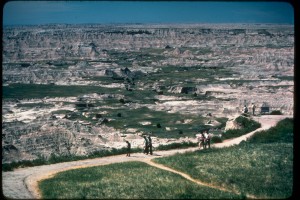In case you missed it, California Governor Jerry Brown proclaimed yesterday as John Muir Day, and he urged Californians to visit one of the state’s “public open spaces.” A bit of a catchall, that—one that would in theory include a municipal parking garage—so he quickly clarified that he meant a “national park, state park or any other unspoiled wilderness.” One critic took the occasion to point out that Brown has a mixed record on the outdoors, signing “a couple of good bills for ocean fisheries” but also promoting “the Bay Delta Conservation Plan (BDCP) to build the peripheral canal to export more water to southern California and corporate agribusiness. If built, this canal will likely result in the extinction of Central Valley steelhead, Sacramento River chinook salmon,” and other “imperiled fish species.”
Today is Earth Day. The 42nd. So, how’s that going for you? Over the years, we’ve seen improvements, surely, alongside melting glaciers and rising waters. Rivers are fire-free, but thick with Asian carp. Better gas mileage. More cars.
Global population exceeded 7 billion last month, so that’s ticked up a bit. Well, actually, it’s pretty much doubled from 3.7 billion in 1970, when we proclaimed the first Earth Day. (By 2050…that’s 38 years from now, a heartbeat in time…we’ll top 9 billion.)
So, keep switching out those light bulbs. Every bit helps…but not that much when you consider what’s going on around the world. Let’s pick on China: The National Geographic reports that China adds a new coal-fired power plant every week; four years ago, Wired said it was actually two a week. NatGeo adds that the “coal power capacity that China has added in the past five years exceeds that of all the U.S. coal power plants combined. By 2015, Chinese capacity is expected to triple that of the United States.”
If you’re feeling a welling up of moral outrage about how irresponsible China is, take a deep breath and look at this for the discussion of carbon leakage. Favorite quote: “It is absurd for a country to export coal to China, buy back goods manufactured there, and then not account for that carbon in figuring their national progress toward reduced emissions.”
The author of those cogent remarks is University of Chicago climate scientist Raymond T. Pierrehumbert, who also addresses the issue of a rational target for carbon in the atmosphere. “Rather than talking about a target concentration, they should be talking about a target cumulative carbon emission. That captures the effect of emission on climate much more succinctly. My own favored number is one trillion tonnes total of carbon (of which we’ve already emitted roughly half). This approximately buys us a 50% chance of avoiding a warming larger than 2C. Still not great odds, but keeping the number under a trillion in my view represents a still challenging target, but a compromise between what may be achievable and staying out of the range of climate change where truly scary things become increasingly likely.”
Recap: If we can stay below a trillion tons of carbon in the atmosphere, we have a 50 percent chance of avoiding a warming that goes above 2C, which is where it starts to get hairy. We’re just halfway to that level, where (again) we have a 50-50 chance of not living in a scorched hellscape. So good news.
Happy John Muir Day. Happy Earth Day.
Photo of Badlands National Park, via the U.S. National Park Service.










